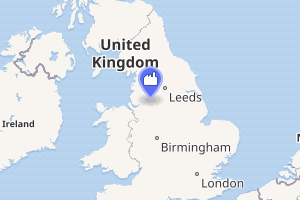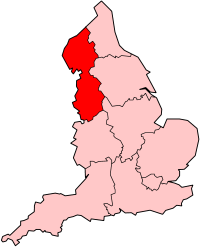Stuart Street Power Station
Stuart Street Power Station was a coal-fired power station in Bradford, Manchester, England.
| Stuart Street Power Station | |
|---|---|

| |
| Country | England |
| Location | Lancashire |
| Coordinates | 53.485760°N 2.192858°W |
| Status | Decommissioned and demolished |
| Commission date | 1900 |
| Decommission date | 1975 |
| Owner(s) | Manchester Corporation 1900-1948; British Electricity Authority (1948–55), Central Electricity Authority (1955–57), Central Electricity Generating Board (1958–75) |
| Operator(s) | As owner |
| Thermal power station | |
| Primary fuel | Coal |
| Turbine technology | Steam turbines and reciprocating engines |
| Power generation | |
| Units decommissioned | All |
| Nameplate capacity | 175MW, 106.75 MW (1923), 184.75 MW (1971) |
| Annual net output | 136.733 GWh (1971) |
grid reference SJ873988 | |
History
The station was built in 1900, and equipped with six Yates and Thom, 2,500hp steam engines, each engine driving an Electrical Co. Ltd, 1,500 kW, three-phase alternator, giving an output of 6,500V at 50 Hz. Babcock & Wilcox supplied 24 boilers fitted with mechanical stokers.[1][2] In 1904, two Wallsend Slipway & Engineering Company, 6000 hp, marine triple-expansion steam engines were installed, each driving a 3,750 kW, 6,500V, three-phase flywheel alternator. Twelve extra boilers by Babcock & Wilcox were installed to drive the new engines. The plant's first turbine-driven generator was installed in 1907.[1]
In 1920, the power station was, with Liverpool Docks, a target for an IRA plot involving its destruction. The plot was foiled when documents were captured and published.[3]
In 1923 the generators at Stuart Street comprised 1 × 5,000 kW, 3 × 6,000 kW, 1 × 6,500 kW, 1 × 7,500 kW, 1 × 8,000 kW, 1 × 15,000 kW, 1 × 18,000 kW and 1 × 25,000 kW steam turbines, plus 1 × 3,750 reciprocating engine.[4] This was a total of 106,750 kW of generating capacity. These machines were driven by a total of 1.728 million pounds per hour of steam (218 kg/s). In 1923 the combined electricity output of the Manchester Corporation electricity department was 224.240 GWh. This was from Stuart Street, Dickinson Street and Bloom Street generating stations.[4]
In 1934, a modernisation programme began which involved practically rebuilding the whole of the site. Metropolitan-Vickers supplied the turbo-alternators, three 30,000 kW and one 25,000 kW. John Thompson Ltd supplied twelve new boilers. Four new concrete cooling towers were also built. Ferguson, Pailin & Co. were awarded the contract for the new switchgear.[5] The work had to be carried out in stages over the following decade so that the plant could be kept running.
After the Second World War, an additional Metropolitan-Vickers, 60,000 kW turbo-alternator, generating at 33,000V was installed along with two large John Thompson boilers. The new boilers were amongst the largest that had hitherto been constructed in the UK and had to be housed in a new building along with the electrostatic precipitators that removed particulates from the flue gases. A new chimney and an additional cooling tower also had to be built for the new boilers.[1]
Coal was supplied from Bradford Colliery via a tunnel containing a conveyor belt.[6] Ash from the boilers was taken away by rail and dumped in the nearby Clayton Vale.[7][8]
In 1948, the station came under the control of the British Electricity Authority following the nationalisation of the electricity supply industry. The station later became part of the Central Electricity Generating Board in 1957.
In 1971 the boilers had a combined steam generating capacity of 1.94 million pounds per hour (538.9 kg/s).[9] The steam conditions were low pressure 350/355 psi (24.1/24.5 bar) and 371/416°C; and high pressure 600 psi (41.4 bar) and 454°C. There was a single 66.5 MW and three 30.75 MW turbo-alternators, and the station had a total generating capacity of 184.75 MW. The electricity output in 1971 was 136.733 GWh.[9]
The generating capacity and output from the high pressure and low pressure plant at Stuart Street is given in the following table.[10][9][11]
| Year | 1954 | 1955 | 1956 | 1957 | 1958 | 1961 | 1962 | 1963 | 1972 |
|---|---|---|---|---|---|---|---|---|---|
| Installed capacity, MW | 58 | 58 | 58 | 58 | 58 | See below | |||
| Electricity output, GWh | 300.432 | 413.753 | 389.268 | 419.958 | 239.669 | ||||
| Year | 1954 | 1955 | 1956 | 1957 | 1958 | 1961 | 1962 | 1963 | 1972 |
|---|---|---|---|---|---|---|---|---|---|
| Installed capacity, MW | 111 | 111 | 111 | 111 | 111 | 179.75 | 179.75 | 184.75 | 184.75 |
| Electricity output, GWh | 367.606 | 299.142 | 364.347 | 296.364 | 353.105 | 544.644 | 500.632 | 517.02 | 136.733 |
In 1946 the combined electricity output of Stuart Street power station was 389.169 GWh of electricity, operating at a load factor of 46.1 per cent, and with a thermal efficiency of 19.15 per cent.[12]
Stuart Street station was closed in 1975.[13]
Demolition took place in the late 1970s; the cooling towers were demolished in February 1978.[14] The station was demolished by MJ Finnigan & Co.[15] The area has been redeveloped and the site is now the location of the Manchester Velodrome.[7]
References
Notes
- Electricity in Manchester 1893-1993 by Roy Frost ISBN 1852160756
- Power Stations in Greater Manchester (PDF), 2001, archived from the original (PDF) on 27 March 2009, retrieved 28 February 2009
- Hart 2003, pp. 150–151
- Electricity Commission (1925). Electricity Supply - 1920-1923. London: HMSO. pp. 62–65.
- Yorkshire Post and Leeds Intelligencer, 3 May 1934, page 6.
- Bradford Colliery, retrieved 28 February 2009
- Philips Park History Walk (PDF), retrieved 30 June 2017
- Clayton Vale History, retrieved 28 February 2009
- CEGB (1972). CEGB Statistical Yearbook 1972. London: CEGB. p. 17.
- Garrett, Frederick C. (ed) (1959). Garcke's Manual of Electricity Supply vol.56. London: Electrical Press. pp. A-127.CS1 maint: extra text: authors list (link)
- CEGB Annual report and Accounts, 1961, 1962 & 1963
- Electricity Commission, Generation of Electricity in Great Britain year ended 31st December 1946. London: HMSO, 1947.
- Walter Warrington Collection, The National Archives, retrieved 23 April 2017
- Stuart Street Power Station, Science & Society Picture Library, retrieved 28 February 2009
- "MJ Finnigan Demolition", mjfdemolition.co.uk, archived from the original on 6 October 2011, retrieved 18 April 2011
Bibliography
- Hart, Peter (2003), The I.R.A. at war, 1916-1923, Oxford University Press, ISBN 0-19-925258-0
External links
- Photograph – the station seen from the Ashton Canal towpath
- Photograph – the station's cooling towers
- Photograph – an internal view of the station
- Photograph – the station's control panel
- Photograph – an aerial view of the station in 1924
